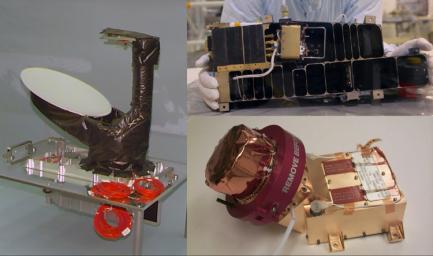
|
U.S. Instruments Aboard Rosetta
- Click the image above for a larger view
- Full-Res JPEG (1986 x 1174) (193.1 kB)
- Full-Res TIFF (1986 x 1174) (7.0 MB)
Caption:
Three of NASA's contributions to the European Space Agency's Rosetta mission are pictured here. An ultraviolet spectrometer called Alice (top right) will analyze gases in the coma and tail and measure the comet's production rates of water and carbon monoxide and dioxide. It will provide information on the surface composition of the nucleus, and make a potentially key measurement of argon, which will be a big clue about what the temperature was in the primordial solar system when the comet's nucleus originally formed (more than 4.6 billion years ago).
Also pictured is the Ion and Electron Sensor (IES) (bottom right), which is part of a suite of five instruments to characterize the plasma environment of the comet -- in particular, its coma, which develops when the comet approaches the sun. The sun's outer atmosphere, the solar wind, interacts with the gas flowing out from the comet, and the instrument will measure the charged particles it comes in contact with as the orbiter approaches the comet's nucleus.
The Microwave Instrument for Rosetta Orbiter (MIRO) (left) specializes in measuring thermal properties. The instrument combines a spectrometer and radiometer, so it can sense temperature and identify chemicals located on or near the comet's surface, and even in the dust and ices jetting out from it. The instrument will also see the gaseous activity through the dusty cloud of material. Rosetta scientists will use it to determine how different materials in the comet change from ice to gas, and to observe how much it changes in temperature as it approaches the sun.
Background Info:
Rosetta is a mission of the European Space Agency, Paris, with contributions from its member states and NASA. Rosetta's Philae lander is provided by a consortium led by the German Aerospace Center, the Max Planck Institute for Solar System Research, the French National Space Agency and the Italian Space Agency. NASA's Jet Propulsion Laboratory, Pasadena, Calif., manages the U.S. contribution to the Rosetta mission for NASA's Science Mission Directorate in Washington. The Microwave Instrument for the Rosetta Orbiter was built at JPL, and JPL is home to its principal investigator, Samuel Gulkis. The Southwest Research Institute, San Antonio, developed the Rosetta orbiter's Ion and Electron Sensor (IES) and is home to its principal investigator, James Burch. The Southwest Research Institute, Boulder, Colo., developed the Alice instrument and is home to its principal investigator, Alan Stern.
More information about Rosetta is available online at http://sci.esa.int/rosetta/ and http://rosetta.jpl.nasa.gov .
Cataloging Keywords:
| Name | Value | Additional Values |
|---|---|---|
| Target | 67P/Churyumov-Gerasimenko | |
| System | Periodic Comets | |
| Target Type | Comet | |
| Mission | Rosetta | |
| Instrument Host | Rosetta Orbiter | Philae Lander |
| Host Type | Orbiter | Lander |
| Instrument | ||
| Detector | ||
| Extra Keywords | Atmosphere, Color, Dust, Infrared, Thermal, Ultraviolet, Water | |
| Acquisition Date | ||
| Release Date | 2014-01-24 | |
| Date in Caption | ||
| Image Credit | NASA/JPL-Caltech/SwRI | |
| Source | photojournal.jpl.nasa.gov/catalog/PIA17664 | |
| Identifier | PIA17664 | |
